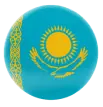
TOPIC: WE HAVE FAMILY HAPPINESS.
Author: Manap Nuray, Kyzylorda oblast, Shieli district,
School gymnasium № 45 "Ak Orda", 6 pupil of "B" class
Leaders: Shaimerden Azatkhan Serikovich, Drawing teacher.
Nurmanova Aliya Dairabayevna , English teacher
In the Kazakh steppe, the ornament is developed in different ways. Each month of the country has its own style and specifics.
Ornamental patterns were used in traditional products of the Kazakh people: weaving, carpets, jewelry, carpet weaving, algae, woolen articles, portfolios, garments, knitwear, embroidery, knitting, decoration and cutting. The content of the article suggests cattle breeding, hunting land and water, migratory scenes, and external images of everyday life. Each ornament is used to decorate, name, and use it in the home.
Scientists believe that currently only 230 species of Kazakh national ornament are identified.
Alkey Margulan divided ornaments into four groups. They are: cosmological, zoomorphic, vegetal, geometric expressions. These include the appearance of external animals, horns, nails, neck, feet, etc. (or zoomorphic) species. Zoomorphic ornaments are commonly seen in ornaments, such as cedar, cuneiform, gypsum, or chandelier. [1.98b]
The ornamental patterns on the side of the skull are often painted vertically, and the beds are almost entirely decorated with a certain rhythm. Sometimes it is a combination of vegetative patterns and a composite composition. The traces of the beasts of the beasts are built on the glaciers, sandwiches, orchards. You can also find this expression on the edges and corners of your home furniture. In a zoomorphic expression, the abstraction form of four herd bears a special place.
An example of this is the ornamentation of raspberries, quails, tomatoes, botany, hashish, jellyfish and many other. The carnation symbolizes the whole life of the Kazakh people. In some cases, it is converted to oats, blackberries, arachnids. The ram is made up of four branches and the middle is like a cross. The quadruple ornament is widely used in embroidery. The wooden surfaces are sometimes sliced to the center, sometimes to the corner.
In wooden products, zooomorphic expressions, called foxes, jackals, hawks, jackals, birds, butterflies, quails, climbers, and flies can be found. They are widely used for embroidery, especially for beds. Another type of Kazakh ornament commonly used in home furniture is plant ornament. They are often found in domestic wooden products. It is found in the form of a leaf, flower, studio, leaf, spruce, root, and new tulips of the overall plant design. Ornamental patterns are often dyed horizontally and vertically on the surface of the crankcase and clamps. On the grinding wheels, these ornaments are interconnected and connected together. Plants produce a variety of wooden products depending on the craftsman's taste. The craftsman used it individually, according to his taste. In wooden products, plant marks are stitched, rolled, or rooted in a circle.
So, in short, our people valued crafts and ornaments from the earliest times. Still, it seems like it's been forgotten. Modern designers and artists do not use the ornament of the Kazakh national ornaments and do not embody their works. In outdoor advertising, home furniture is less common in home interior, some do not even use it.
Many choose European or Oriental (Chinese) styles. Where did the designer come from, and where did he come from? Of course, we do. That is why we do not tolerate the erroneous generation, the generation of our future, for the national handicrafts.
There is a great deal of ways to prevent this, including improving the status of fine arts, introducing systematic training of applied arts in all schools. What we have to do is, first of all, to create a sense of national consciousness of the younger generation, secondly, to open the way to the young talent, and thirdly, to deepen the attitude of the ordinary people, who appreciate the overall art. Today there are craft books about crafts and ornaments, but there are no books for children in school. There are a lot of young people who are interested in handicrafts in secondary schools, but few teachers are learning.
Aesthetic education should be provided to schoolchildren by teaching the folk crafts. From the very first day of school life, the art of learning, as a means of shaping a child's outlook on the world, teaches the world to be perceived in a uniform sense, evaluates and figuratively shapes. Having mastered artistic activities in various art forms, the person not only learns the practical skills of the artist, but also carries out creative ideas, and also teaches himself a sophistication.
She gains the ability to find the beauty of what she sees in her everyday life, her ability to imagine, develop, analyze and analyze creativity. These qualities are needed for everyone. The owner of any business will do the job even if he has the ability to master and use visual aids.
To solve the above issues, first of all, it is necessary to increase the professional training of artists-teachers, to improve the quality of education, secondly, to ensure the financial condition of artists-teachers and to raise their legal status, and thirdly, to increase the care for national arts and culture, support for cultural heritage at the state level, and publishing smaller magazines for students, students, and handicrafts, and craftsmanship husband passed as a subject in school, youth enterprising, promote national culture süyuine the future rewards are obvious.
Famous artist Abilkhan Kasteyev asked "Where did you learn from ornaments?"
"From the source of the mountain,
From the sheep's ear,
From my mother's felt
From the horns of the goats. "
And I would answer that question from my elder sister and grandfather in the village. In my understanding, ornaments are precision, accountability, equality, equality, harmony, harmony, decorative, artistic, coincidence, cleanliness, tenderness, love, reasonableness, warmth, beauty, thought, intelligence, intelligence, good mood, inspiration , educates, craftsmanship, skill, flexibility, accuracy. Love for art, love for beauty, passion collection. The heart is warm and delicate. The reason for studying and protecting today's topic is the education of these people. My father is a master-clerk who teaches hooks and whistles on the whip, and my grandmother is a master who teaches young women to sneeze, sew napkins, and sew napkins. I am always proud of the things that are made of their hands. In the future I would like to learn from those men and to implement them.
A. Margulan. Decorative Arts in Kazakhstan.
Almaty 1986
2. Seit Kenzheakhmetuly. Traditions of Kazakh cultural traditions,
Almaty, 2006
3. Kazakh culture. Encyclopedic Reference.
Almaty: "Aruna Ltd.", 2005
4. Z. Mukhamedzhanov Kazakh table art.
Cognitive Publication. "Almatykitap" publishing house, 2009
5. National costumes of the Kazakh people "Almatykitap" publishing house, 2011
6. Toktabayeva Sh.Zh. History of Kazakhstan, 2004 №4
7. A. Iskakovna Sukhak Art "Almatykitap" publishing house, 2007
8. Omirbekova Kazakh ornaments.
"Almatykitap" Ltd., 2005
жүктеу мүмкіндігіне ие боласыз
Бұл материал сайт қолданушысы жариялаған. Материалдың ішінде жазылған барлық ақпаратқа жауапкершілікті жариялаған қолданушы жауап береді. Ұстаз тілегі тек ақпаратты таратуға қолдау көрсетеді. Егер материал сіздің авторлық құқығыңызды бұзған болса немесе басқа да себептермен сайттан өшіру керек деп ойласаңыз осында жазыңыз
Оюмен ойын айтқан елміз
Оюмен ойын айтқан елміз
TOPIC: WE HAVE FAMILY HAPPINESS.
Author: Manap Nuray, Kyzylorda oblast, Shieli district,
School gymnasium № 45 "Ak Orda", 6 pupil of "B" class
Leaders: Shaimerden Azatkhan Serikovich, Drawing teacher.
Nurmanova Aliya Dairabayevna , English teacher
In the Kazakh steppe, the ornament is developed in different ways. Each month of the country has its own style and specifics.
Ornamental patterns were used in traditional products of the Kazakh people: weaving, carpets, jewelry, carpet weaving, algae, woolen articles, portfolios, garments, knitwear, embroidery, knitting, decoration and cutting. The content of the article suggests cattle breeding, hunting land and water, migratory scenes, and external images of everyday life. Each ornament is used to decorate, name, and use it in the home.
Scientists believe that currently only 230 species of Kazakh national ornament are identified.
Alkey Margulan divided ornaments into four groups. They are: cosmological, zoomorphic, vegetal, geometric expressions. These include the appearance of external animals, horns, nails, neck, feet, etc. (or zoomorphic) species. Zoomorphic ornaments are commonly seen in ornaments, such as cedar, cuneiform, gypsum, or chandelier. [1.98b]
The ornamental patterns on the side of the skull are often painted vertically, and the beds are almost entirely decorated with a certain rhythm. Sometimes it is a combination of vegetative patterns and a composite composition. The traces of the beasts of the beasts are built on the glaciers, sandwiches, orchards. You can also find this expression on the edges and corners of your home furniture. In a zoomorphic expression, the abstraction form of four herd bears a special place.
An example of this is the ornamentation of raspberries, quails, tomatoes, botany, hashish, jellyfish and many other. The carnation symbolizes the whole life of the Kazakh people. In some cases, it is converted to oats, blackberries, arachnids. The ram is made up of four branches and the middle is like a cross. The quadruple ornament is widely used in embroidery. The wooden surfaces are sometimes sliced to the center, sometimes to the corner.
In wooden products, zooomorphic expressions, called foxes, jackals, hawks, jackals, birds, butterflies, quails, climbers, and flies can be found. They are widely used for embroidery, especially for beds. Another type of Kazakh ornament commonly used in home furniture is plant ornament. They are often found in domestic wooden products. It is found in the form of a leaf, flower, studio, leaf, spruce, root, and new tulips of the overall plant design. Ornamental patterns are often dyed horizontally and vertically on the surface of the crankcase and clamps. On the grinding wheels, these ornaments are interconnected and connected together. Plants produce a variety of wooden products depending on the craftsman's taste. The craftsman used it individually, according to his taste. In wooden products, plant marks are stitched, rolled, or rooted in a circle.
So, in short, our people valued crafts and ornaments from the earliest times. Still, it seems like it's been forgotten. Modern designers and artists do not use the ornament of the Kazakh national ornaments and do not embody their works. In outdoor advertising, home furniture is less common in home interior, some do not even use it.
Many choose European or Oriental (Chinese) styles. Where did the designer come from, and where did he come from? Of course, we do. That is why we do not tolerate the erroneous generation, the generation of our future, for the national handicrafts.
There is a great deal of ways to prevent this, including improving the status of fine arts, introducing systematic training of applied arts in all schools. What we have to do is, first of all, to create a sense of national consciousness of the younger generation, secondly, to open the way to the young talent, and thirdly, to deepen the attitude of the ordinary people, who appreciate the overall art. Today there are craft books about crafts and ornaments, but there are no books for children in school. There are a lot of young people who are interested in handicrafts in secondary schools, but few teachers are learning.
Aesthetic education should be provided to schoolchildren by teaching the folk crafts. From the very first day of school life, the art of learning, as a means of shaping a child's outlook on the world, teaches the world to be perceived in a uniform sense, evaluates and figuratively shapes. Having mastered artistic activities in various art forms, the person not only learns the practical skills of the artist, but also carries out creative ideas, and also teaches himself a sophistication.
She gains the ability to find the beauty of what she sees in her everyday life, her ability to imagine, develop, analyze and analyze creativity. These qualities are needed for everyone. The owner of any business will do the job even if he has the ability to master and use visual aids.
To solve the above issues, first of all, it is necessary to increase the professional training of artists-teachers, to improve the quality of education, secondly, to ensure the financial condition of artists-teachers and to raise their legal status, and thirdly, to increase the care for national arts and culture, support for cultural heritage at the state level, and publishing smaller magazines for students, students, and handicrafts, and craftsmanship husband passed as a subject in school, youth enterprising, promote national culture süyuine the future rewards are obvious.
Famous artist Abilkhan Kasteyev asked "Where did you learn from ornaments?"
"From the source of the mountain,
From the sheep's ear,
From my mother's felt
From the horns of the goats. "
And I would answer that question from my elder sister and grandfather in the village. In my understanding, ornaments are precision, accountability, equality, equality, harmony, harmony, decorative, artistic, coincidence, cleanliness, tenderness, love, reasonableness, warmth, beauty, thought, intelligence, intelligence, good mood, inspiration , educates, craftsmanship, skill, flexibility, accuracy. Love for art, love for beauty, passion collection. The heart is warm and delicate. The reason for studying and protecting today's topic is the education of these people. My father is a master-clerk who teaches hooks and whistles on the whip, and my grandmother is a master who teaches young women to sneeze, sew napkins, and sew napkins. I am always proud of the things that are made of their hands. In the future I would like to learn from those men and to implement them.
A. Margulan. Decorative Arts in Kazakhstan.
Almaty 1986
2. Seit Kenzheakhmetuly. Traditions of Kazakh cultural traditions,
Almaty, 2006
3. Kazakh culture. Encyclopedic Reference.
Almaty: "Aruna Ltd.", 2005
4. Z. Mukhamedzhanov Kazakh table art.
Cognitive Publication. "Almatykitap" publishing house, 2009
5. National costumes of the Kazakh people "Almatykitap" publishing house, 2011
6. Toktabayeva Sh.Zh. History of Kazakhstan, 2004 №4
7. A. Iskakovna Sukhak Art "Almatykitap" publishing house, 2007
8. Omirbekova Kazakh ornaments.
"Almatykitap" Ltd., 2005

шағым қалдыра аласыз















